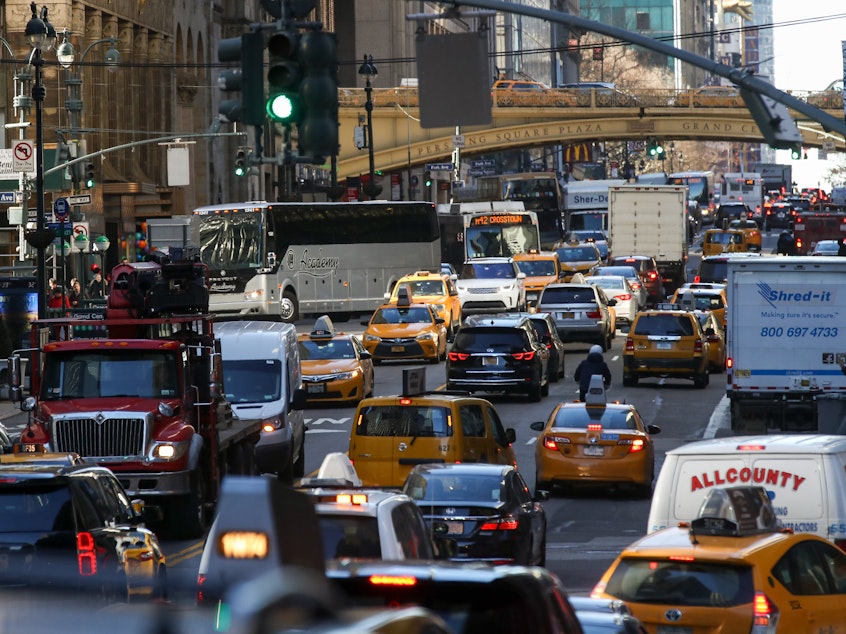City Dwellers Don't Like The Idea Of Congestion Pricing — But They Get Over It

New York City is preparing to become the first urban area in the U.S. to adopt congestion pricing — a fee for drivers entering the city center, designed to reduce gridlock and help fund the city's struggling subway system.
And nearly two years before the fees are put in place, a poll by Quinnipiac University found that 54% of New Yorkers are opposed to the change in policy. That's no surprise to experts on transportation policy.
According to years of research, when a city prepares to adopt congestion pricing, residents are largely against the effort.
But once the new charges are in place public opinion shifts, sometimes dramatically, in favor of the new reality.
New York City's policy, which was adopted by state legislators in Albany, will go into effect in 2021. Interest groups are currently vying for exemptions from the fees, which are expected to be more than $10 per day.
On a recent afternoon, pedestrians on 60th Street — the future dividing line to mark where congestion pricing will kick in — were split, rather predictably, on the question of congestion pricing.
People who don't drive were swift to endorse the plan. "Less driving, more public transportation: It's all a positive, really," said Sam Shainberg.
Meanwhile, drivers who would have to pay the toll were firmly opposed. "I commute into the city from Queens and I'm paying for tolls already," said Beatrice Carre. "It's enough. We're paying enough."
"The city is so unaffordable as it is," Darren Kronenberg said. "They've got to come up with something better ... try to raise money someplace else."
It's a familiar response. In cities around the world, plans to add congestion fees have been met with outcry from drivers who feel that the policies are unfair or pile on top of expenses they're already paying.
In the months before congestion pricing is in place, the resentment can be deep. In Stockholm, just 30 percent of residents were in favor of congestion pricing before it started in 2006.
But the plan went into effect anyway. And after congestion pricing was permanently in place, a majority of Stockholm residents supported it.
"It was absolutely astonishing," says Jonas Eliasson, a researcher and former transport administrator in Stockholm.
He says that he and other traffic experts at the time had expected that the plan would work, in terms of achieving its policy goals.
"We would reduce congestion: We didn't really doubt that," Eliasson says. "But this huge change in public opinion was something that we hadn't really prepared for."
It was a similar story in London in 2003 — over the course of a few months, public support for congestion pricing went from 40% to nearly 60%. The patterns has been observed in other European cities that adopted forms of road pricing.
When congestion pricing is just a vague notion, not tied to a specific proposal, people like it. As soon as it's a real thing with a start date — and a sticker price — they pivot against it, diving into what Eliasson calls the "valley of political death." But once it becomes a reality, they come back around to support it.
One obvious explanation for the shift is that reality exceeds expectations.
"It's actually better than you think," Eliasson says. "The other side of the coin, it's not actually as bad as you thought."
That is, before pricing kicks in, people don't really expect it to work. (New Yorkers are living with this skepticism now, according to Quinnipiac's poll.) But when it does work — and traffic experts say it generally does — people experience the benefits firsthand.
At the same time, residents might discover it's not as difficult as they thought to drive less often, or drive during less busy times.
But there's another explanation, too.
"Just inertia," says Maria Börjesson, an economist with the Swedish National Road and Transport Research Institute. "People tend to accept the way it is."
Börjesson looked at congestion pricing in Gothenburg, Sweden, where support for congestion pricing went up markedly after the policy was actually in place.
But in Gothenburg, people didn't actually change their mind about how effective congestion pricing is
"They actually had grasped pretty well what the outcome would be even before" the policy kicked in, Börjesson says. "But still, the support increased."
People like the status quo, and can adapt pretty quickly to a new one, it turns out — whether the status quo is gridlock or a fee to keep traffic flowing. [Copyright 2019 NPR]



